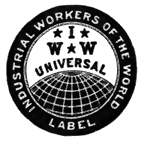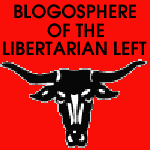Larry Gambone recently wrote on
Any Time Now Discussion:
...Latin Americans are well aware that Castro-the-dictator is as much a US production as a self-creation. US policy has always been what they can’t overthrow from outside, they destroy from inside by driving a progressive government in as authoritarian direction as possible.
I've long taken a favorable view of Hannah Arendt's observation, in
On Revolution, that virtually every revolution has significant decentralizing elements: attempts at worker self-management, local organs of direct democracy, etc. A classic example is the soviets and the workers committees in Russia, before Lenin either liquidated or coopted them. And outside pressure on a revolutionary regime and foreign support for counter-revolutionary forces (e.g., the Western states' support for the White armies in Russia) tends to strengthen the forces of consolidation and centralization, and to accelerate the suppression of decentralist tendencies.
I recall Chomsky arguing somewhere that the NLF, despite definite authoritarian aspects, at least was also engaged in grass-roots activities of genuine benefit at the village level like building irrigation systems, organizing peasant cooperatives, and the like. It had more genuine attachments to the peasants of the South than did the ruling party in Hanoi, at any rate. The main effect of the U.S. war effort in the South was to atomize civil society in the countryside, along with successfully decimating the NLF. The result was a hollowed-out shell, the almost total supplanting of the guerrillas by the NVA, and the filling of the void by the North Vietnamese state when Saigon collapsed.
In the specific case of Cuba, I'm not sure how much of Castro-the-dictator was just in there waiting for an opportunity to come out, but the pressures of the Cold War--the U.S. economic embargo, combined with increasing alignment with the USSR--certainly helped to bring his authoritarianism out. Via
Fruits of Our Labour, I found an interesting account of the early post-revolutionary period in Cuba, a chapter in
Cuba, Castro and Socialism, by Peter Binns and Mike Gonzalez. It appears that cooperative and "petty bourgeois" elements were heavily represented, if not predominant, in Castro's early economic policies.
The Cuban Communist Party, before the revolution, had had a checkered history of on-again, off-again collaboration with Batista. The Communist Party certainly had little use for the 26 July movement before it came to power. Castro, on the other hand, came from a background of nationalist opposition centered on what Binn and Gonzales call "petit bourgeois" elements and a "fundamentally non-working class tradition": the "urban middle class" and "middle farmers, small peasants and university students," supplemented by "the semi-incorporation of the organised working class."
Indeed, if I recall correctly, Castro actually liquidated the CCP for unacceptable competition with his own revolutionary movement after coming to power. When he declared himself a "Marxist-Leninist" in the early 1960s, he incorporated the remnants of the old CCP into his own revolutionary party.
Binns and Gonzalez, with typical Marxist blinders, see Castro's increasingly statist economic policy as a response to "objective conditions." The land reforms and other curtailments of exploitation left the laboring classes with more disposable income and greater demand for consumer goods, which (non sequitur alert) could only be met by nationalizing the economy:
So why then did Castro move towards the creation of a monolithic statised economy? The major reason must be found in his long standing commitment to diversify the economy, to end its dependency on the US and the vagaries of the world sugar market, and to all-round economic development. The question that came to be posed in the summer of 1959 was this: how were the reforms of the first part of the year to be paid for? The rapid increase in wages, the fall in unemployment, the drastic reduction in rents (up to 50%), the cheapening of electricity, telephone and medicine charges; all put much more money into the workers’ pockets. This automatically increased the demand for consumption goods – all of which had to be imported – and food. The latter automatically put pressure on the land available for sugar; and since this provided Cuba with more than 80% of the exports from which the imports had to be paid, this situation could not be allowed to persist indefinitely. Only industrialisation and diversification could solve the problem. The fantastic variability in the price of sugar, and Cuba’s almost total dependency on it as a source of foreign earnings, meant that the level of demand in the domestic economy was much too unpredictable for most capitalists to want to take the risk of relying on it as a source of income. And, without that, no advantage attached to investing productive capital in Cuba. With a very small and highly unpredictable home market, and with just about the highest wage levels in Latin America, there was not the least chance of the situation changing if the bourgeoisie was simply left to its own devices.
The matter was made more acute by land reform. Again this was a long standing commitment of Castro’s from the mid-1950s: antipathy to the latifundistas, the huge landowners, was the cornerstone of Castro’s radical liberal programme. The May 1959 Land Reform Act has to be seen in this light. It was in no way a socialist measure, nor one which led to collectivisation in any other form. It abolished only the very largest estates (those of more than 402 hectares; though even here there were exceptions which allowed much bigger farms – up to 1,342 hectares – that were efficient to continue), and it did not solve the problem of the indebtedness of the small peasant. Indeed one prominent agronomist sharply contrasted the 1959 reform with those in East Europe in the early 1950s; and suggested strong parallels with those in Italy in 1949-50 instead. Yet for all that, something like 25% of the cultivable land was covered by the Act, and was distributed to the poorer peasants. The effect was to increase the proportion of land that was devoted to immediate consumption rather than providing the country with an exportable surplus, and this added considerably to Cuba’s problems. Although it was also true that much of the land previously owned by the latifundistas was poorly tended, the fact remained that to increase productivity significantly would have required levels of investment and skilled personnel that were just not available at the time.
The initial reforms were thus in no way reminiscent of the state-capitalist “collectivisations” of Eastern Europe in the 1950s, nor Cuba’s own 1963 reform; but what they did do was to create a situation that only a state-capitalist programme could solve.
I'm not sure why this is. If the standard of living had increased so much (rents cut in half, the highest wages in Latin America), why was it so self-evidently beyond the producing classes to pool their own surplus for investment? Why could peasants not have cooperatively invested in labor-saving technology to increase their own productivity, and free up labor for other forms of production? In any case, if the increased prosperity of Cuban society created more purchasing power, and the increased demand for consumer goods could be met by importation, why was that a "problem" to be addressed through the state? Domestic industry would expand at the point when native producers could supply consumer goods more cheaply than the foreign manufacturers. And if anything, the removal of hindrances on cooperative marketing would have made the sugar industry less dependent on the vagaries of world commodity markets. In the meantime, the domestic agricultural sector would have been increasingly diversified with staple crops for domestic consumption, and the peasantry would have been capable at least of feeding itself on its own land, with a little surplus for buying a few luxuries from abroad: a marked improvement over the Batista dictatorship, I'd say.
I'm guessing a lot of this stems from the affinity for blockbuster industrialization projects and a religious faith in economies of scale (faith, because they're "things not seen" beyond relatively low levels of output). It also probably owes something to an implicit assumption that large-scale industrialization can only be carried out by some far-seeing "progressive" class against the will of the producing classes: either "primitive accumulation" on the model of the Western enclosures and expropriations, or "socialist accumulation" on the Stalinist model. Either way, the producing classes will just sit around comfortably chewing their cud unless they're driven like beasts into the factories.
The hyper-mechanization of agriculture that was brought about under influence of Russian aid was actually less efficient, as shown by the
increased standard of living produced by intensive farming on the neighborhood scale since the post-Soviet collapse of Cuban mechanized farming. During the years of Soviet support, Cuba was locked into a neocolonial policy of growing sugar for the Soviet bloc on giant agribusiness plantations (sorry, collective farms) in return for consumer goods. Hmmm--sound familiar? Since the end of fraternal assistance between progressive peoples, and all that,
....Cuba... learned to stop exporting sugar and instead started growing its own food again, growing it on small private farms and thousands of pocket-sized urban market gardens—and, lacking chemicals and fertilizers, much of that food became de facto organic. Somehow, the combination worked. Cubans have as much food as they did before the Soviet Union collapsed. They’re still short of meat, and the milk supply remains a real problem, but their caloric intake has returned to normal....
In so doing they have created what may be the world’s largest working model of a semi-sustainable agriculture, one that doesn’t rely nearly as heavily as the rest of the world does on oil, on chemicals, on shipping vast quantities of food back and forth.
Anyway, justified or not, Castro probably
did see the cutoff of U.S. aid following the land reform as forcing him into an increasingly statist path of industrialization.
It was the 1959 land reform – limited though it was – which first brought a reaction from the USA. Before that America and its multinationals coexisted peaceably enough with the new regime. But after it things were quite different. A substantial amount of US-owned land was involved and Washington demanded full and immediate compensation for lands seized in the 1959 Act; it refused financial support to the Cuban regime, supported the most reactionary of the Batista followers who had now become refugees in Miami, and even began to aid their piratical attacks on Cuba itself.
From the Autumn of 1959 through 1960 events moved very rapidly. Faced with the refusal of the USA to grant aid, and an economy that could not survive in its old laissez-faire form without such aid, Castro was forced to use the state in a much more activist way in the economy. In September 1959 he announced that henceforth economic development would have to take place under the auspices of the state. On the land the property gained by Batista’s followers during his regime was confiscated at the end of the year. About 400 cooperatives and 485 Peoples Stores (designed to eliminate rural profiteers) were set up by the newly established INRA (National Association of Agrarian Reform). But Castro at this point still hung back from nationalisation measures.
The latter were adopted in response to more active economic warfare by the U.S.
The next phase in Cuba’s attempt to break from the stranglehold of dependence was connected with oil. The USSR agreed to supply a limited amount of crude to Cuba in the summer of 1960 in exchange for sugar. But the multinationals – Texaco, Shell and Esso – refused to refine it in their Cuban refineries. The Cuban government reacted swiftly, seizing the installations at the end of June 1960. Within a week, Eisenhower had cancelled Cuba’s remaining quota of sugar imports to the USA. This was followed immediately by the confiscation of about $800m of US corporation property – in oil, sugar, electricity and mines. The USA responded with a total trade embargo to and from Cuba – a devastating economic blow given Cuba’s total dependence on the US connection. Finally the Cuban regime completed its hold on industry in October 1960 with the nationalisation of the banks, hotels, cinemas and most of the factories and shops.
In the face of sabre rattling by Kennedy and a genuine threat of invasion, Cuba became increasingly totalitarian. One manifestation of this was the so-called "Committees for the Defence of the Revolution" (CDRs), which were "[o]rganised on a block-by-block basis, [for the purpose of forming] small squads of vigilantes to observe and report on possible fifth columnists amongst the erstwhile lackeys of Batista and the US multinationals."
Meanwhile, as Castro increasingly resorted to autarky under the U.S. embargo, a major part of those engaged in commerce and the skilled professions left the country. Binns and Gonzalez describe the middle class exodus in a disparaging tone that I consider completely uncalled for:
the social basis of support for the old order within Cuba itself was being rapidly eliminated by the fundamental changes that the nationalisation and land reform measures were producing. More than 1/2 million refugees left Cuba in the first 3 years of the Castro regime, unable to make a living from The exploitation of others any more. First to go were the beneficiaries of US tourism: the US banned its citizens from travelling to Cuba, and this led to the 10,000 pimps, the 27,000 croupiers, and many other hangers-on leaving. Then followed the business men, the Batista ex-officers, the pampered state officials, the elite professions, the landowners and so on. However much the US might have wanted to put the clock back, by 1961 the layers of Cuban society that would have enabled them to “Cubanise” any return to the old order had more or less disappeared. The Castro regime had quite effectively removed opposition to its continued rule.
No kidding. But it seems to me he had to create the opposition before he could remove it. During the early days of his regime, virtually the entire opposition came from Batista's officers and the latifundia owners who'd been expropriated by a fully justified land reform. To demonize the entire commercial middle class, putting it into the same category as landlord and military oligarchs and corrupt state officials, is insane.
And rather than a gradual and peaceful path to industrialization, with the increasingly prosperous laboring classes cooperatively pooling their own surplus as capital, Castro and Che were left with the prospect of imposing industrialization as a top-down on a virtually gutted society. The very petty bourgeois classes who had been the backbone of Castro's revolution had fled the country.
But I get the distinct impression that American policy elites not only helped all this to happen, but that they actually
preferred a totalitarian Cuba with a nationalized economy, over the path the country appeared to have been taking after the initial land reform. If Jones couldn't be brought back, Orwell's neighboring farmers preferred at least that the pigs run Animal Farm into the ground, rather than that the animals succeed in peacefully working it with their own labor. A "petty bourgeois" Cuba of peasant proprietors and small tradesmen and storekeepers, peacefully producing and trading without paying tribute to an oligarchy of landlords and generals, would have been even more distasteful to the proponents of "free enterprise" in the U.S. than to Marxists like Binns and Gonzalez.
There is a Cuban revolution to be reclaimed by anti-statists--much like the Russian revolution before the Congress of Soviets was purged and the anti-Bolshevik Left liquidated, when the soviets were still genuine organs of self-government and the workers' committees still functioned in the factories. Castro and the Miami reactionaries, likewise, are not our only choices.








